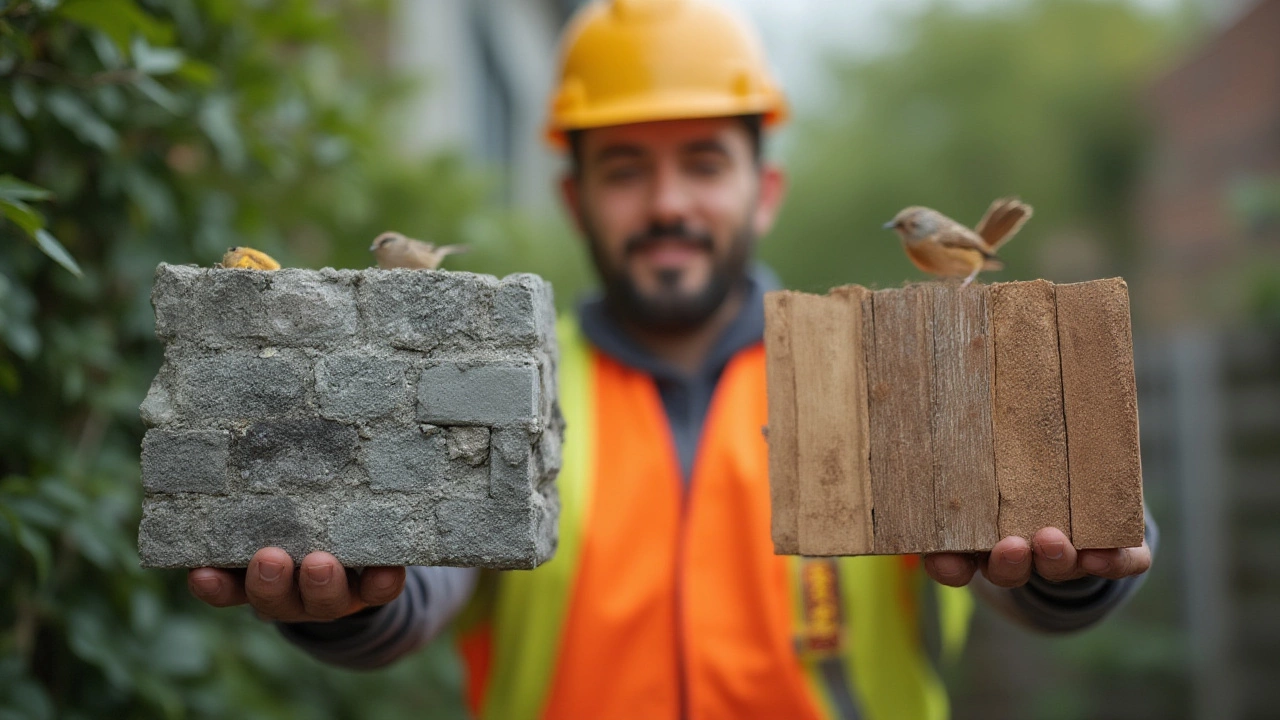Did you know that the average new house in the US leaves behind a mountain of waste—about 8,000 pounds of it? Most people don’t think twice about the materials behind their walls, under their feet, or overhead. They're just happy the paint isn't peeling and the windows don't rattle in the wind. But here's the uncomfortable truth: what keeps out the rain and keeps us cozy often costs the earth way more than we realize.
Why Some Building Materials Are Bad News for the Planet
Let’s talk concrete for a second. This stuff seems harmless—it’s everywhere, from highways to high-rises. But the cement industry (that’s what holds concrete together) is a climate villain, pumping out about 8% of the world's CO2 emissions. Imagine tossing more than 2 billion tons of carbon dioxide into the sky every year, just for sidewalks, floors, and city skylines. Traditional concrete needs a high-temp process that relies on burning fossil fuels, so every new slab leaves a carbon stamp that lingers for centuries.
Then we have aluminum. It feels nice and lightweight in your hand, but it’s seriously energy-hungry. Making just one ton of virgin aluminum can gulp up about 14,000 kWh of electricity (that’s the power two households would use over a whole year). Most of the world’s aluminum is made where electricity comes from coal, multiplying its carbon damage. Studies from Yale University highlight that if aluminum demand keeps rising, emissions could balloon by 50% by 2050.
Brick and kiln-fired tiles? Classic but problematic. Their charm hides the fact that most bricks are fired at over 1,000°C, typically in coal-fired kilns. This process isn’t just energy-intensive; it also releases harmful pollutants—think sulfur dioxide, carbon monoxide, and even mercury—into the air that nearby communities breathe every day.
PVC (polyvinyl chloride)—the world’s third most widely used plastic—shows up in pipes, windows, and flooring. It comes with a suitcase full of issues. Producing PVC releases dioxins, a toxic group of chemicals that accumulate in the food chain. They don’t break down easily, and exposure is linked to serious health risks for both humans and the animals around us.
Let’s not forget formaldehyde-laced pressed wood products like cheap cabinets and laminate flooring. Formaldehyde might keep your cabinets intact, but as it off-gasses, it pollutes indoor air for years. Even ‘low-VOC’ labeled materials can sometimes trick you—there’s no universal standard for those labels.
Take a step back and add up the hidden impacts: biodiversity loss, toxic air in manufacturing towns, and resource depletion. Every beam, brick, or tile made from the wrong stuff takes a slice out of our planet’s future. If you care about eco-friendly living, knowing what to avoid is half the battle.

The Usual Suspects: Building Materials to Avoid
Some materials just keep popping up on every ‘don’t build with this’ list. Here’s where the problems really pile up—both for the planet and the people living with the finished product.
- Concrete (Traditional Portland Cement): You already know the cement story. Adding insult to injury, most sand used in concrete is dredged from rivers, wrecking aquatic life and local water cycles. Even worse, demolition creates tons of concrete waste, most of which ends up crushed into landfill.
- Asphalt (Bitumen): The black stuff on roads and roofs is made from petroleum. It off-gasses hazardous volatile organic compounds (VOCs) during installation and continues leaching chemicals into stormwater for years.
- Virgin Metals (Aluminum, Copper, Steel): Mining these tears up natural habitats, releases heavy metals, and demands mountains of energy for refining. If the metals aren’t recycled, the impact just keeps stacking up.
- PVC and Vinyl: As mentioned above, these plastics—and most synthetic flooring like vinyl—bring dioxins and phthalates into your home. Some studies link the plasticizers used in vinyl to hormone disruption in kids and pets.
- Pressure-Treated Wood: What’s protecting your deck or fence from rot? Usually, it’s chemical cocktails including arsenic, copper, and chromium. These can seep into soil and groundwater and are tough to handle safely after use.
- Fiberglass Insulation: Not only does this insulation use a ton of energy in manufacturing, but tiny glass fibers can irritate lungs and skin during installation—and the binder resins sometimes contain formaldehyde, too. Unprotected workers have had respiratory problems linked to this stuff for decades.
- Traditional Bricks and Tiles: As described, their manufacturing methods are energy hogs and pollution sources.
- Gypsum Drywall: Mining gypsum devastates landscapes, and drywall waste is one of the biggest contributors to landfill mass. Wet scraps create hydrogen sulfide gas—a rotten-egg poison—as they decompose.
- Lead-Based or Toxic Paints: Yes, lead paint is ‘banned’ in most places, but older homes still leak lead particles into remodelers’ lungs. Cheap imports may not follow the rules, either. If you see suspicious paint or smell odd fumes, test before you sand or strip.
Even insulation gets dicey. Spray foam insulation contains isocyanates and other toxic chemicals—these can off-gas for months, triggering asthma or allergic reactions. And because most foam is made with hydrofluorocarbons, the climate impact is massive. One study out of MIT calculated that using spray foam can increase a building’s lifetime greenhouse impact by as much as 500 times compared to natural options.
Keep an eye on transportation, too. Heavy stuff shipped from thousands of miles away racks up ‘embodied carbon’ before it even arrives on your plot. Granite countertops from Brazil or marble from Italy? These travel more than some people do in a decade, which means more fossil fuels burned just for the look.
Toxic finishes are often the finishing straw. Varnishes, sealants, and waterproofers are often loaded with VOCs. If you ever got dizzy while painting a floor or sealing a deck, that's why. These fumes hang around and can interfere with sleep, trigger headaches, or cause respiratory problems for sensitive folks.

How to Choose Greener Alternatives—And Why It Matters
Now that you know what to dodge, how do you pick better stuff? The first tip: always ask “Where did this come from? How is it made?” When you look closer, the best building materials usually involve less processing, natural origins, and a smaller energy footprint.
Instead of concrete everywhere, consider limecrete (made with lime instead of portland cement) or rammed earth, which uses local soil and minimal additives. Bamboo substitutes can be five times stronger than concrete—yes, really—and they grow back much faster than trees. Straw bale, hempcrete, and recycled steel (using mostly scrap metal) cut emissions by 50% or more. These might sound unconventional, but there are centuries-old buildings in Europe made with lime and straw still standing strong.
Reclaimed materials are a double win for DIYers and pros. Salvaged wood flooring, used bricks, and antique windows not only skip the energy-heavy manufacturing process but also give a home instant character. Look for certified reclaimed lumber with traceable origins so you know it wasn’t yanked from a protected forest.
Natural insulation options—think sheep’s wool, recycled denim, or cellulose (made from old newspapers)—do the job without the chemical storm. They also tend to regulate humidity better, making for a more comfortable home year-round.
Solid timber—even better if it’s FSC-certified—works for framing, flooring, and walls. Trees absorb carbon as they grow, and properly managed forests regrow and lock away even more CO2. Modular fiber cement boards, which use minimal cement and mostly recycled fibers, are a massive leap from traditional sheetrock and last almost forever.
If you need metals, always opt for recycled content. The energy used to recycle aluminum is just 5% of what it takes to make it virgin. Steel with high recycled content is easy to find, thanks to countries with long histories in metalwork, like Germany and Sweden.
Low- or no-VOC paints and finishes keep your air clear, and water-based sealants are less polluting during manufacturing. Even ‘bio-based’ plastics (made from cornstarch or sugarcane) are popping up in place of PVC for modern windows and piping.
- Look for certifications like FSC, Cradle to Cradle, GREENGUARD, and Declare Label. These aren’t buzzwords—they guide you to manufacturers who do the hard work to cut emissions, use safe chemicals, and source materials responsibly.
- Go for locally sourced materials whenever possible. Not only do you reduce transportation emissions, but you also support your regional economy and are more likely to find workers who know how to use those materials best.
- Think about the end of your building’s life. Can it be reused, recycled, or safely composted? Design for disassembly is an emerging trend—meaning your house won’t clog up landfills if it needs to come down.
Your choices make a clear difference. The International Energy Agency recently reported that with sustainable choices, new building emissions could be cut in half by 2050. That's the scale of action we need on a warming earth.
The bottom line? Choosing the right materials isn’t just another eco-fad. It’s the most powerful way you can lower your environmental impact, make your home healthier, and even inspire neighbors to do the same. Imagine the ripple effect if every new roof, wall, or floor helped heal the planet instead of hurt it. That’s not just a nice idea—it’s the future, if we demand it.
